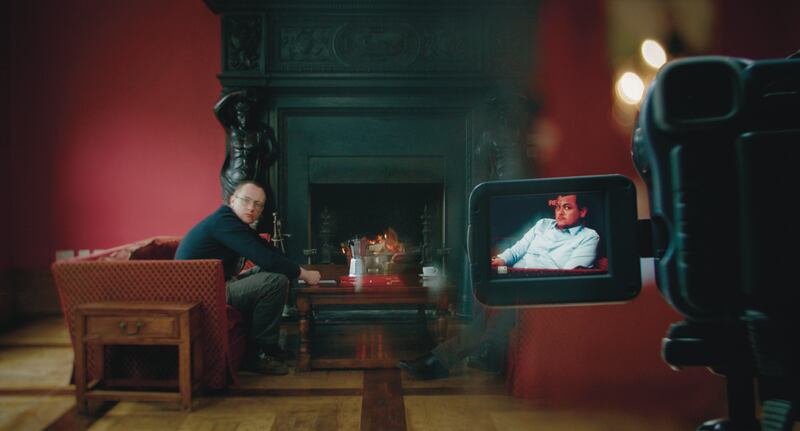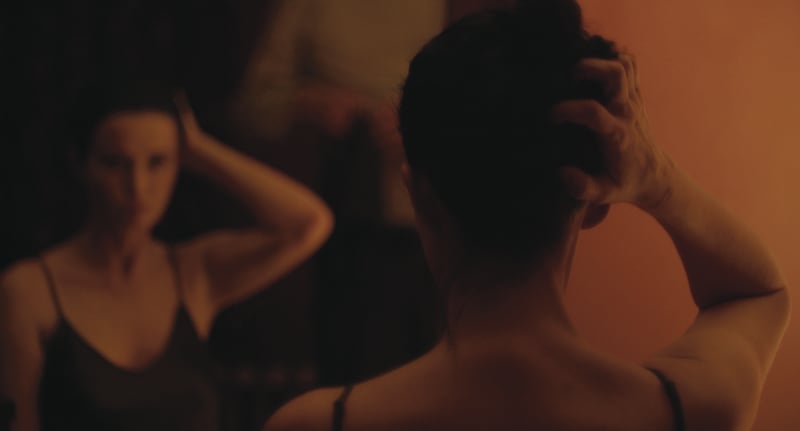We are already getting some sense of how future generations will define the “pandemic movie”. At the more well-heeled end of the spectrum, Hollywood studios, unwilling or unable to send their cast into the streets, green-screened the heck out of even the most mundane sequences in superhero flicks. Lower-budgeted films spent a little too much time in the same room.
Then there is a small strain of films that, either consciously or not, profited from the changed circumstances. Dean Kavanagh’s extraordinary Hole in the Head is just such a project. The playful, experimental Irish feature, financed wholly by the Arts Council of Ireland, stars John Curran as John Kline jnr, a largely mute projectionist and filmmaker – he communicates via the “speak text” mode on his smartphone – who hires actors to play his parents in an attempt to piece together childhood mysteries. Isolated in a remote mansion, the “actors”, played by Lynette Callaghan and James Devereaux, become increasingly fraught as John blankly records their every move.
Nothing about the personable Dean Kavanagh suggests a similarly creepy agenda. But the pressures of the pandemic regulations must have made it easier to summon up that closed-in paranoia.
“It was a complete coincidence,” Kavanagh says. “The story was written a few years before, but it was always going to be a kind of chamber piece – a chamber piece that exploded out of the one space. The hardest part is getting people together into a room. But no one had anything else to do. Also, the roads were all dead. It was quite scary. Nobody knew anything. The day before we began shooting I phoned up the Department of Culture. They were really good. They actually rang me back!”
‘A lot of children die’: Patrick Freyne reports from inside Chad camps for Sudanese refugees
Emer McLysaght: The Irish live for a sunny day, but with it comes the pressure of having the ‘perfect’ day
Inside Trump’s reversal on tariffs: how fear and panic overtook president’s ‘gut instinct’
Eddie Molloy: There is one risk to Ireland’s future progress that dwarfs even pandemics, terrorism and tariffs

So am I right in saying that the conditions helped the actors lean into the paranoia? Maybe they are not always acting.
“Yeah, I think one of the main issues when we’re shooting rurally was wifi connectivity,” he says. “When people finish their schedule for the day they want to reach out to their partner or their family or their friends. And they can’t do that. They have to go up a hill or they have to walk to a different room. I noticed this happening. It was a weird kind of thing. I started noticing that people were getting a little bit edgy. They were realising they’re in the middle of nowhere.”
Here is where the shoot got properly odd.
Fragmented screenplay
“So I had this typewriter,” he says. “I started making these little notes. They were almost like the fragmented screenplay that the lead character was developing. I started making them for each character, written through his persona, and leaving them for these people at different times. Some of them are really strange – like diary entries: ‘Midnight. I have woken up in a terrible sweat. I have kissed myself.’ Sometimes uncomfortable. They never said anything back on that. But you could tell they’d read them. So the lines were blurring between the film and the outside world – it being such a distant thing.”
As you will have gathered, Kavanagh, a Wicklow man, is not a conventional film-maker. Over the last decade and half, working on limited budgets, he has created some 70 shorts and six feature films. The work rarely fits mainstream templates. He has a particular interest in exploring the possibilities of the widest range of visual and audio recording equipment. You will find footage shot on 70mm, 35mm, 16mm, 9.5mm and 8mm celluloid among his work. He is equally happy toying with camera phones and the newest digital cameras. The meld of found footage, manipulated imagery and off-beam performance in his features is concerned with testing the media to their limits, but, amid all the head-scratchery, there is always a strain of ironic wit.

Since graduation from Dublin Institute of Technology on Aungier Street (as it then still was), Kavanagh has developed a day job in digitising images and related technical work. He has long been a stalwart at the Irish Film Institute.
“My job there is mostly tech,” he explains. “There’s a small curatorial aspect to it as well, but it’s mostly technical. But, even when I was there, I never really pushed for my own films. Usually because they’re too bloody weird. Ha ha!”
Kavanagh grew up in Kilcoole and then, when he was nine, moved with his family to Greystones. He remembers his mother being “not very pleased” when he announced that he was going to film school, but he seems to have done all right for himself. I get the sense he has been balancing the practical with the creative pretty effectively for the last 15 years or so. While that was happening, Irish film was bursting out of its shell. The industry picked up Oscar nominations. Domestic actors became stars. Maybe the more experimental, more avant garde end of the art became slightly lost in the conversation. Films such as Pat Collins’s Silence or Donal Forman’s Out of Here should be as celebrated as those pictures recognised in the Dolby Arena.
“You have films, like the Marvel films, which have this tight template of how you must make a film,” Kavanagh says. “I think that that has affected the viewers’ and the filmmakers’ appetite for something a little bit off the beaten tracks – a little bit stranger in form and in content. I think that’s had an impact. I think people, certainly for my generation, have turned towards a type of filmmaking that is by the numbers.”
One-liners
Hole in the Head, Kavanagh’s first film with synched dialogue, is certainly not by the numbers. Long, still shots follow the hero as he messes about mysteriously in rural streams and by odd rocky protrusions. We are sometimes unsure if we are watching footage of the recreation or footage of the events being recreated. There may be a film within a film within a film. Hang on. Now we are seeing shots of the chap doing the voiceover. One’s brow may occasionally furrow, but Hole in the Head is always at home to intrigue and humour. The mystery of the parents’ disappearance tags the action. There are even proper chortle-out-loud one-liners. Pondering the records bequeathed by an agriculturally mutilated ancestor of John Kline’s, the narrator notes: “Much like the thresher, he left very little behind.” You could not accuse a film of being po-faced that finds space for Lonnie Donegan’s My Old Man’s a Dustman in its later stages.
“The main thing for me was that, as regards the protagonist, no one’s ever really laughing at him,” Kavanagh says. “You’re laughing at the situation that he finds himself in. There is a kind of nihilism – or maybe just more of a pessimistic sense of humour – that surrounds him at any given moment. He’s using all these devices that could at any given time decide not to work properly. Everything is conspiring against him. There is something very funny in that. Something almost Pythonesque.”

There seems little danger of Kavanagh being sucked into the Marvel Cinematic Universe. He is firmly in control of his own aesthetic and articulate in his defence of the sideways approach. One can scarcely guess what might come next.
“I was writing another film that was much bigger,” he says. “It was like a post-apocalyptic film. I wrote one draft and then I priced it and thought: oh, no, no, no. Ha, ha! So I put that on the backburner. But I’d really like to do a stripped-down version of that. I would like to pursue that. That happens in an almost prehistoric future where people use older technology to communicate.”
Before then he has the pleasure of a commercial release. It seems his film was not too “bloody weird” for the IFI after all. That cinema will screen Hole in the Head, which premiered to much positivity at the Galway Film Fleadh, from August 12th. This marks a shift in his career. To this point, his films have shown in festivals and on streaming services such as Vimeo. I assume it must feel like a different business to finally have paying punters (we hope) trundling into public spaces.
“Exactly. Usually it’s always been in a festival context or in some kind arts-type context, where there’s a one-off show or there are two shows,” he says. “In those situations only certain type of people will go. So this is quite exciting… and terrifying.”
Hole in the Head plays at the Irish Film Institute from August 12th














